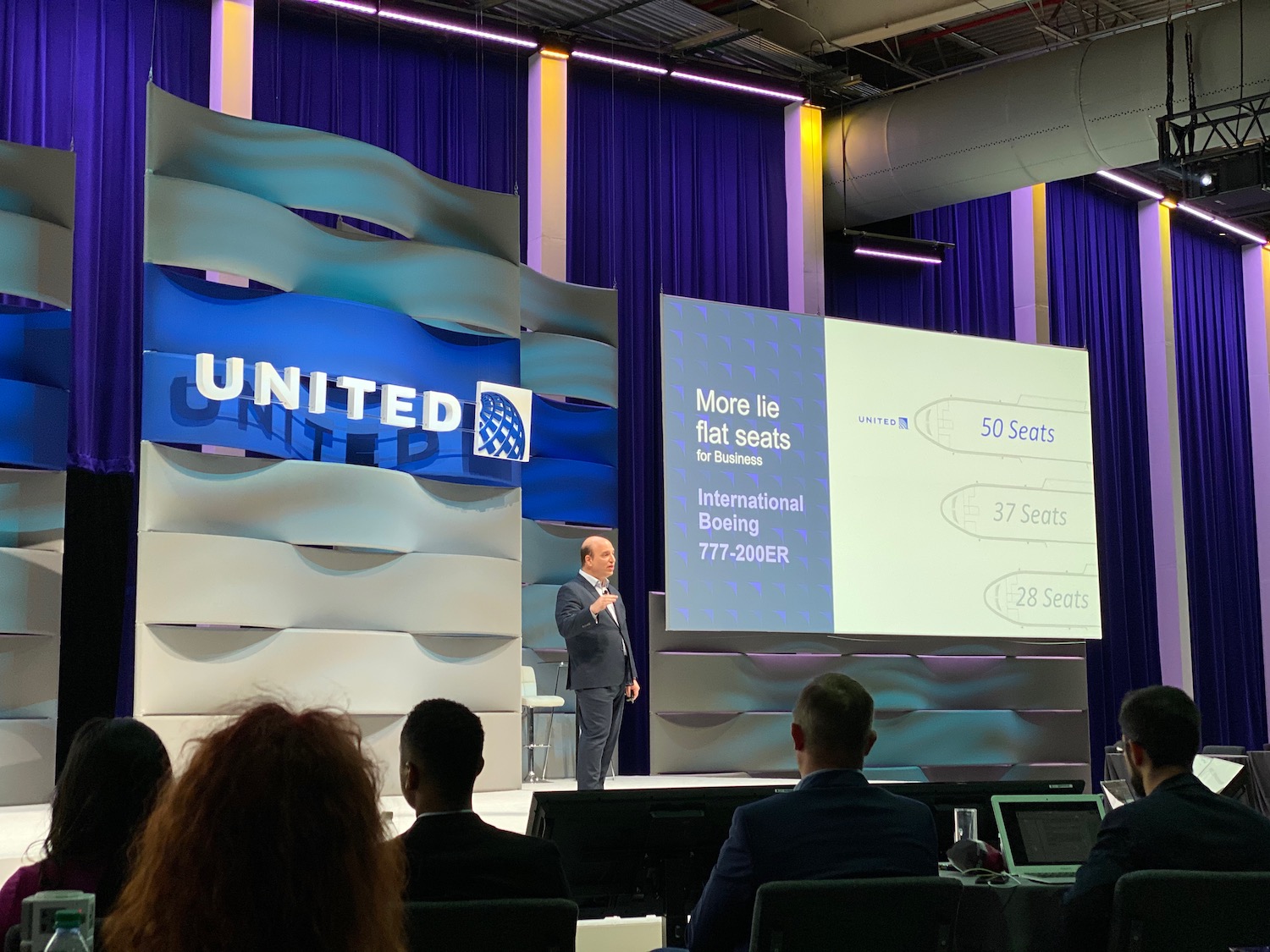
United Airlines held an earnings call yesterday to discuss its 2023 first quarter loss. During that meeting, a pair of interesting observations was revealed by CEO Scott Kirby and CCO Andrew Nocella on the current nature and market of international traffic.
United Airlines CEO And COO Explain International Traffic Shift
The pre-pandemic model of international traffic involved a seasonal surge (during the summer schedule) to more leisure-oriented destinations with year-round service to European partner hubs and other important cities including Frankfurt, London, and Zurich. While that model continues, on this side of the pandemic, Kirby shared that demand has appeared far more seasonally cyclical:
“There appears to be a clear change in seasonality that is causing peak leisure demand months, March through October to be even stronger, while months that were historically reliant on business demand are weaker, that particularly impacts January, February, and the first half of November and December. We believe demand is just structurally different than it was pre-pandemic and we are still figuring out that new normal.”
United maintained an aggressive transatlantic schedule this winter but anyone who flew on United surely noticed that upgrades were easier than ever and flight often went out with a lot of open seats. While that does not directly indicate profit or loss, it does indicate that supply outstripped demand this season in a way I have not seen in the past.
In the past, I could hop on a flight to Zurich or London during the winter months and see more than half the economy class cabin empty, but the front cabin topically was full or close to full. That was not the case this year, particularly in the London market.
Meanwhile, United’s new routes to Australia and secondary cities in Europe have been profitable from day one according to Nocella. Asked by Jamie Baker of JP Morgan about the profitability of new markets, Nocella was surprisingly candid:
“There is – for global long haul, there is virtually no spool up right now, Jamie. It gives us – the supply-demand equation is just not what it’s ever been in the past. While United supply across the Atlantic and Pacific is dramatically up and we’re happy it is dramatically up, obviously, industry supply is down. So what I would tell you is that the new routes come in very quickly with very strong profitability, which is why we keep adding them.”
But Nocella echoed Kirby’s remark of weakness in London and other key hubs:
“That being said, in terms of same-store sales, I will say that London Heathrow is probably our weakest at this point because there is just – that there is a large amount of capacity in London Heathrow relative to the rest of the world, and we’ve grown there. And our connections within Europe in our key hubs are – have not fully recovered, just like they haven’t domestically. And so we actually do see some relative weakness in certain parts of the global network off of a strong base. But the new routes to your question are just coming in with home runs on day one.”
If you’re wondering why United announced a trio of new routes to the South Pacific this week, this explains why. United is not seeing the profit it projected in traditional markets and is therefore shifting to other markets in an attempt to respond to shifting (and in some cases create) demand.
CONCLUSION
When it comes to international travel, United Airlines has observed a new trend of deeper valleys and steeper peaks of demand. The practical result may be less flying to Europe and London during the winter months as United looks to more effectively utilize its fleet of aircraft. But if many new routes are profitable from day one, expect to continue to see more experimentation from Patrick Quayle, United’s Senior Vice President of Global Network Planning and Alliances, in the months and years ahead.
image of Andrew Nocella taken by me in 2019




Not related but you might want to check into a story on Silver Airlines in Florida being way behind on airport fees. Tampa and Fort Lauderdale at a minimum and it seems like a threat to their survival.
That’s already been settled. Silver is staying put.
No, they made ANOTHER repayment plan agreement, which is their 4th. Not sure how they are going to be able to make them if they couldn’t in the past. At best they found a way to buy more time.
Not sure what they expecting to change that will allow them to make the past payments along with current ones. It’s going to be a bigger story in the near future.
Sounds like they’re going to be evicted from FLL.
Very interesting to hear Heathrow is struggling, I wonder in what context. Are they losing money to Heathrow, or are the yields just not what they’ve been historically because there is too much capacity? The loads still seem solid to Heathrow.
Also Matthew – unrelated but if you haven’t already you should check out Airline Videos behind the scenes tour of UA LAX operations – the legendary Bruce makes an appearance. He’s almost to 50 years at United, what an achievement!
Love BTS airline vids https://www.youtube.com/watch?v=7ODwdMojVwo
Agent on Demand is interesting, haven’t heard of this but found your article on it https://liveandletsfly.com/united-airlines-agent-on-demand/
I wouldn’t be surprised if some of the decline in LHR is due to Brexit. Before Brexit, it was pretty common to have itineraries that used UA metal from the US to LHR, then *A metal on to continental Europe. With the UK’s departure from the EU, there’s definitely been a lot of complaints about the process of entering the UK from Europe and that’s had a knock on effect decreasing traffic between the EU and UK.
I think the implied context is that pre-pandemic business class travel could cover the lack of economy demand in the winter, but now those trips are replaced by a lot of Zoom meetings. I’m sure UK Brexit and a weak economy there don’t help either, but I’ll bet the normalization of Zoom meetings has replaced a lot of business class demand to LHR.
Could it have anything to do with the soft product? If people are really wowed by Polaris (food and service) and hard product remains decent, then I think it will make a difference. Perhaps people shifted carriers or loyalty based upon the same.
Matt, sorry this is off topic. Love the blog, but for some reason I find your font and background color extremely hard to read versus other websites. Have you ever considered changing the font to make it easier to read? The letters almost feel too thin and blur together easily. If you never heard this before ignore it. But if other have noticed it too, just something to consider.
Have considered. Stay tuned. We are looking into it.
Please, please, PLEASE change the font!!! The one on your points site is PERFECT!
True, easier on the eyes. https://awardexpert.com
I love this font personally but you could always zoom to make it more legible. I do agree the white background isn’t the best. Dark mode would be nice 🙂 Night mode in Windows or macOS or iOS helps, and/or f.lux app. https://justgetflux.com
Regarding LHR, I have noticed a fair amount of LHR-connecting UA saver award space in the coming months. However, I have been choosing BA, a better soft product – food, beverage and service – at lower cost, with more upgrade ability at booking and competitive lounges to Polaris in a number of US cities or the UA lounge at LHR.
I suspect the economic situation in the UK is having an impact in addition to changes wrought by the pandemic.
Agreed.
I live in a small vacation reliant city. During off months the fares are reasonable. Touristy months, fares are beyond most folks that live here can afford.
I doubt United will give up Heathrow slots; wonder if we’ll see the 757 replace some of the 767s out of Newark
Some of UAL flights @LHR utilized slots owned by *Alliance partners. It will be a lot cheaper to maintain slot usage by flying from London to nearby European cities than Continental U.S.
I’m ready for the 797
It’s funny and obviously I am using my anecdotal experience which is not worth much but- I travel about once a month internationally for work, and have done for over ten years, and pay up to business class if I can’t use miles/points, on United and I have found it universally hard to get upgrades, and the prices on United have been much higher than I’ve ever seen across the board to all the places I go the last year (Africa, Latin America, middle East etc). It is frustrating and led me to try flying AA to Argentina in paid business but then they messed up my whole trip so now I am back at United and wishing I could figure out why the prices are so high when I am seeing empty Polaris seats. Like regularly well over $2000 higher than normal (and even google flights agrees).
Business travel will no longer be the driver of air travel going forward. It’s going to be leisure
Premium leisure will ay for int’l F. This is why a F-O-Y cabin is the proper structure.
The days of J may be limited since businesses will just not pay for J, when they actually allow travel
Makes sense overall about J but also confusing as AA is doing away with F, as well. Maybe UA needs to pause this retrofit so they can truly get it right
Guy in picture looks like Larry Kellner; in my head I”m hearing him talking about his “co-workers, who are in the best in the industry, are committed to providing clean, safe and reliable service”
United should offer one way tickets more freely. As a biz traveler I buy a lot of those, which means not flying UA when they otherwise could have my business.
LHR has been a godsend as of late both for redemptions from the continent using Star Alliance carriers to connect there and for plus points upgrades. This explains a lot. They are at three times daily now to IAD as a single market example and it’s clear that the other two alliances utilizing Virgin and BA are dominating any connecting traffic prior. And to an extent originating traffic.
Seems to me that the smart strategy would be to alleviate any non-stop flights from London that are west of Houston and focus on feeder traffic connecting in IAD, ORD, EWR, and IAH. Use larger aircraft than the 767 for each and give yourself a fighting chance for U.S. connecting passengers originating in London. The flights to the West Coast basically alleviate too many markets east of there and clearly do not justify non-stops.
But what do I know.
@Stuart Makes sense. And ” what do you know”? A wealth of knowledge and always a great contributor to this blog ;· )
true
Stuart! Don’t touch my twice daily LAX nonstops on United! 😉
Seems on the surface that LAX should have service although Stuart makes valid points. Does it need to be twice daily though
Don’t kill the messenger!
They’re just figuring out that traffic falls off a cliff to Europe from November through the end of February? Someone should give these two a raise. Nothing’s changed at all. There is a surge on TATL between April and September or into early October and then it gets very quiet for a few months. Australia and New Zealand peak demand from the US is in November-April. What morons.
That’s not entirely true. Certain markets for sure carried a more seasonal change as to demand both now and in the past. But London, the example they cited, prior to Covid was fairly consistent throughout the year because business travel would still hold in periods like November and February. That’s changed, and exactly what’s to their point. Business travel has not recovered, and may never go back to pre-covid levels.
The takeaway from this presser is that leisure travel is ruling the day now. And business travel, unless you are connecting two Star Alliance hubs , especially those on the west coast (i.e. FRA and LAX) are just not sustainable at 2019 levels.
Can they succeed financially on leisure travel ruling the day?
Heck if I know. But it seems it is the case in many markets. And with more strategic shuffling of flights and schedules to be seasonal, they are making it work, for now that is. The question is more to what this leads to. In, say, two years. If business travel has not rebounded by then (which is probable from all we are seeing) and leisure travel begins to wane a bit off the trend it’s on, the outcome could be dismal for airlines.
I’ll bet that there are a lot of analysts looking at this over and over and shaking their heads trying to predict the next moment. I bet as well that they are reporting that the best any airline can do now is stay nimble, be ready to adjust, and do not commit to anything. It’s sort of like dating in your early 20’s.
Or dating in your 30’s/40’s 🙂
All excellent points and thank you for the insight. I guess the majors are going to need to be more nimble like startups like Breeze. No idea how they are doing and if they will succeed but they offered new seasonal non-stop obviously domestic service from both of my home airports last year, but now this year is including a stop.
Annoying after a decade of waiting for direct service but I guess the majors are going to need to do similar reshuffling to survive, as you’ve explained. It will be interesting to see who comes out on top in all of this. I am hoping Oscar’s new book sheds more light on all of this, as these discussions are very interesting.
Should there be a recession later this year or next, you can expect much of the demand for what typically does not work outside peak season on US-Europe to be aggressively suspended and return to April-September/October schedules. Delta has already twice pruned schedules, as an example.
Interestingly, some of Europe has been seeing substantially more “off Season” demand. Greece is starting to become a year round destination and Delta’s JFK is almost not seasonal anymore. I could see parts of Italy following suit, along with Portugal and Spain continuing. The latter have generally continued to see winter demand from Europeans, and the right marketing could pull in Americans too.
I am London-based and frequently United’s fares are higher than others. London to the USA is extremely competitive and their revenue management people should be able to fill planes with a little price tweaking. Also, they might deploy a few planes to other destinations. In July I am flying paid business class to SEA on BA because United has no non-stop and BA does. If United flew LHR-SEA a couple of times a week it would pick up enough business to be profitable.
Matt, I’m curious when you speak to senior execs at UA about its routes, do you ever inquire or discuss resumption of old UA routes or flying to specific new destinations both internationally and domestically? For example, UA touts itself as a global airline yet it never resumed flying to BKK or SGN, locations with huge populations and growing middle class. Closer to home, UA seems to have ceded the entire southeast US to Delta and AA. Why is that? Would be interested to hear UA’s take on this.
I’ve asked about BKK and been told, generally, that market conditions do not allow for it.
I completely avoid LHR,CDG,FRA,and AMS,just not the way I want to start or end a trip.Recently flew transatlantic into Vienna and onto Montenegro,absolutely wonderful,the way an airport should be,ditto ZRH and COP.
Is United ever going to have direct flights to Southeast Asia(BKK, SGN) from the mainland?